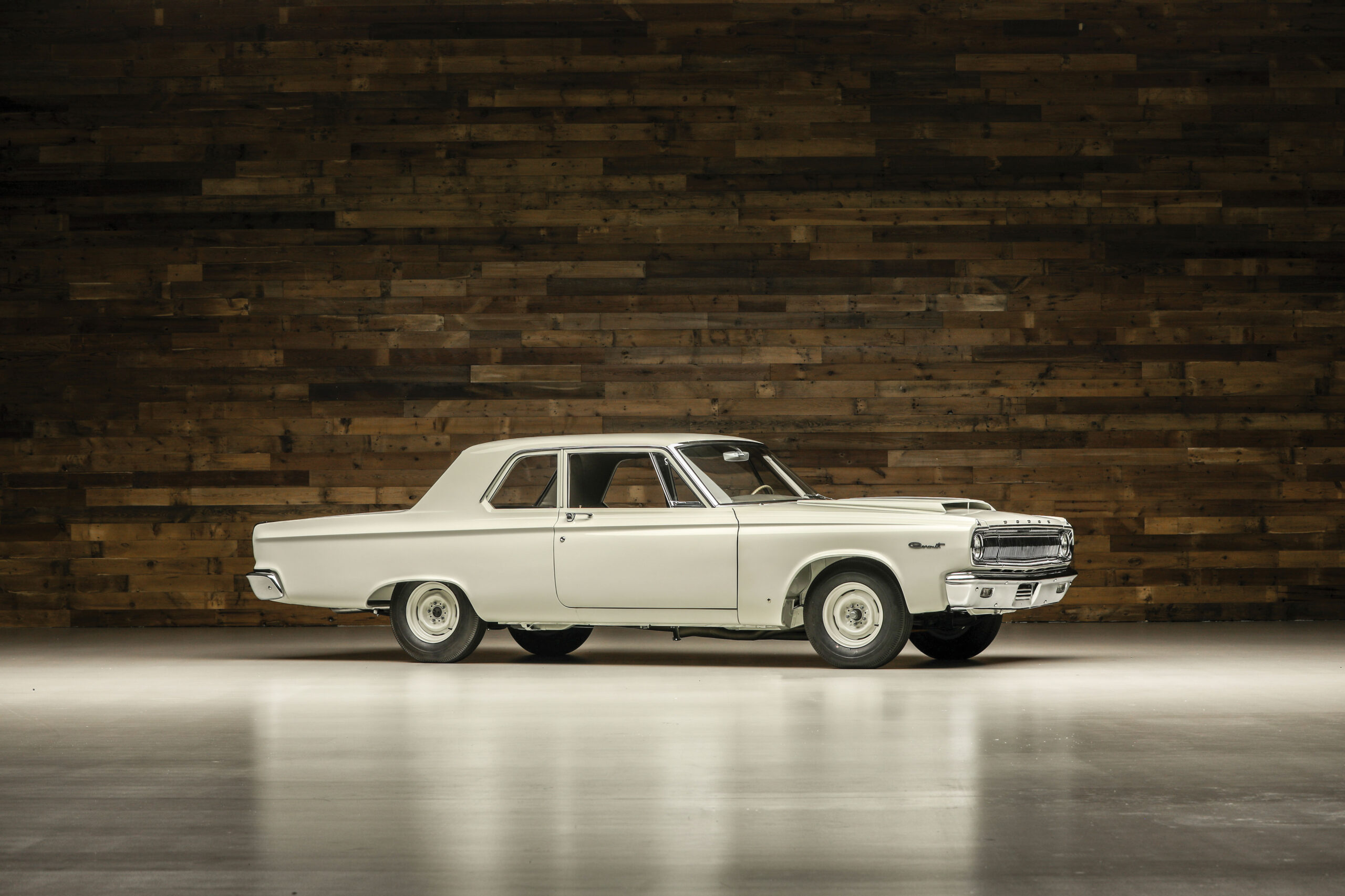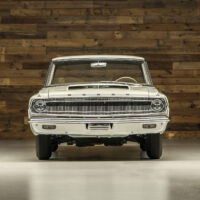Chrysler allowed the development of its Hemi engine for one real purpose: to win races. However, NASCAR in 1964 decided that Chrysler’s engine was not acceptable on its racetracks. Plan B was to build a factory car that would dominate the stock classes in NHRA-sanctioned drag racing. Thus was born the era of “A990” Super Stock cars. A total of just 102 Plymouth Belvederes were produced and only 101 Dodge Coronets, one of which we are honored to offer.
This is one of those very special Super Stock Dodge Coronets that has been carefully inspected and restored to its original configuration. According to the original fender tag, it was painted white at the Lynch Road factory. The serial number starting with “WO” was used only on the Super Stock cars; it is a badge of honor. Close inspection of this Dodge will find that mounting holes under the hood for the battery were never used; same for splash guards and sill plates.
Amazingly, this car was never tubbed-out or altered and retains all of its factory body panels, glass, radiator, exhaust system and even the muffler. The Hemi engine is date-code correct and was completely rebuilt by Wheeler Racing Engines of Minneapolis. Many original items remain, such as the Prestolite ignition and original steel headers, which have been restored. Both the 727 TorqueFlite transmission and rear axle are original to this car.
Because this car was not meant to be used on public roadways, it was never registered. As a result, the original Manufacturer’s Statement of Origin, or MSO, is included, as will be the original bill of sale dated April 16, 1965. Of the 101 Dodge Coronet Super Stocks produced, only a handful have survived. It is believed that this example is the most factory-correct restoration and would be the centerpiece of any performance-oriented collection.
SCM Analysis
Detailing
| Vehicle: | 1965 Dodge Coronet A990 Lightweight |
| Years Produced: | 1965 |
| Number Produced: | 101 |
| Tune Up Cost: | $500 |
| Chassis Number Location: | Pad on top of the block near the water pump |
| Engine Number Location: | VIN plate on the driver’s side instrument panel behind windshield |
| Club Info: | WPC Car Club |
| Website: | http://www.chryslerclub.org |
| Alternatives: | 1962 Chevrolet Impala SS Z-11, 1963 Ford Galaxie R-code, 1965 Plymouth Belvedere A990 |
This car, Lot 266, sold for $109,200, including buyer’s premium, at Worldwide Auctioneers’ Auburn, IN auction on September 1, 2023.
The Super Stock class was the most popular form of drag racing in the early to mid-1960s, pitting stock-looking factory-built racers in classic Chevy vs. Ford vs. Pontiac vs. Mopar competition. Conceptually, these performance machines were similar to some of today’s top-shelf performance cars: street legal (barely) but fully intended for track use. Winning came down to the talent of the engine tuner and driver skill. The driver was critical. Tom Hoover of the Dodge Ramchargers racing team (and father of the 426 Hemi) once told me racing Super Stocks was “like driving on ice” due to the required narrow slicks.
Bare bones, big power
Dodge and Plymouth Super Stocks built in 1965, designated internally as “A990,” began with the most basic 2-door “post coupe” sedan made. The more-stylish hard tops could not withstand the body-twisting torque of a big 426 Hemi V8. Windshields and rear windows were known to blow right out of a hooked-up, twisted-up hard top.
Coming down Chrysler’s Lynch Road assembly line in Detroit, mixed in with regular production cars, they were built without sound deadening or the caulk between unibody sections. Other weight savings came from bucket seats borrowed from the Dodge A100 vans, and any unnecessary components were eliminated including armrests, heater, radio, outside rear-view mirrors, sill plates and step guards as well as the entire back seat. The side glass was replaced with special Corning lightweight items, and the rear side windows were fixed in place. Even the inner high-beam headlights were eliminated, and the battery was relocated to the trunk, all to remove as much front-end weight as possible (rear-weight bias is desired in drag racing).
Most A990s used Chrysler’s famed A727 TorqueFlite transmission, since Hoover discovered the softer launch of an automatic provided better traction with those narrow tires than a manual. Standard was an axle with 4.56:1 gears good for drag racing only, and a 426 Race Hemi hand-built at Chrysler Marine in Marysville, MI, producing well over 500 hp.
Raced, not wrecked
This Dodge A990 was initially delivered to Kolesar’s Garage in Westfield, PA, in April 1965. With a sticker price of $4,799, it was sold to George McAndrews of Wellsville, NY, for $1,000 plus a trade of his 1965 Dodge Coronet daily driver. The intention had to be local drag racing since the A990 was never titled, and a letter from McAndrews to a subsequent owner said, “No matter which drag strip we took it to, we always won.” McAndrews claimed it would run the quarter mile in the “low 10s” at around 134 mph, which was quite fast for the time, making the unbeaten claim believable.
But the life of a race car is hardly charmed. Engines are blown, transmissions, axles and other major components destroyed, and when their useful life is over, racers were often parted out or scrapped. Yet somehow McAndrews’ Dodge remained amazingly preserved. It’s been restored, and the engine has been replaced (not a surprise with these types of vehicles) but it was properly done with one that’s period correct. Even more impressive is the original documentation present; it’s quite remarkable to have the build sheet and especially the MSO on any car from this era, much less a racer.
Realistic expectations
The sale price of $109,200 would seem disappointing in light of the rarity and originality of this Dodge. Common Hemi-powered Dodge and Plymouth road cars from this era often sell for more. One possible explanation might be the lack of serious racing provenance. Yet Mecum tried in 2017 (and again in 2019) to sell the 1965 Plymouth Belvedere A990 — same car, same assembly line, but Plymouth sheet metal — with which Ed Miller and Kip Guenther won the first-ever NHRA Super Stock World Championship in 1967. The high bid was just $130k without selling. Even Bill “The Connecticut Yankee” Flynn’s famous fuel-injected “Yankee Peddler,” one of 12 factory “altered wheelbase” A990 racers that were the genesis of the Funny Car drag-racing class, sold for only $176,000 in 2019 (after bringing $787,500 in 2006). Typical A990 cars, even in excellent condition, average around $110k.
Let’s face it, these factory lightweight drag racers look like a taxicab in a plain wrapper. Most auto enthusiasts seeing the McAndrews Dodge will give it a resounding “meh,” while only a Mopar fanatic with a serious case of “Dodge Fever” will recognize it for its historical significance. Plus, drag racing has a pretty niche following. All that reduces the number of potential bidders at any auction to a select few, and that keeps prices low and appreciation slow. Even for the best example, $109,200 is about all that could be expected. Both buyer and seller should be happy with this result. ♦
(Introductory description courtesy of Worldwide Auctioneers.)




